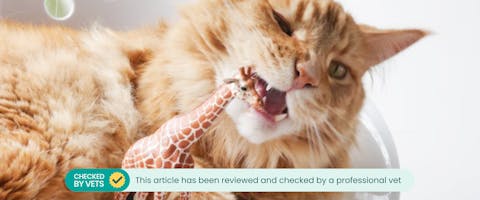Updated 23/09/2024
Cats are known to be rather picky eaters. With sensitive tummies and a selective diet, it’s not unusual for kitties to turn their furry noses up at something they used to favor. But what happens if they decide to eat nonfood items?
Pica in cats might sound cute, but it can cause serious health problems in your cat, and be a sign of distress or a medical issue. Let’s find out more about what is pica in cats, pica in cats treatment solutions, and what causes pica in cats to develop in the first place.
Trending posts
Purr-use some of the top blogs our members have been loving this month- Top male dog names for your new furry friendGot a new furry family member in your pack? Check…

- Top female dog names for your new fluffy palWelcoming a new pooch into your family? Explore…

- 250+ gray cat names your silver feline will loveRecently welcomed a fluffy gray bundle of joy into…

- What are normal pet sitting rates?Discover the average pet sitting rates for animals…

- Unique dog names to stand out from the packDare to be different with our list of the best…

What is pica in cats?
Pica is a compulsive disorder that can lead a cat to chew, suckle, or even eat non-edible items like electrical cords, clothing, bedding, furniture, or other household items. While pica is not life-threatening as an illness, it can lead to some physical health issues or other compulsive behaviors to deal with mental stress. Often these objects can be harmful to kitties, causing stomach issues by becoming lodged in their digestive systems, other internal harm, or even poisoning.
Pica in cats is usually seen in young cats or kittens, but cats can develop pica at any age. It’s not a common disorder and some kittens may simply grow out of these naughty nibble habits.
Symptoms of pica in cats
A few of these pica symptoms in cats might seem like we’re stating the obvious - if they’re trying to eat the remote, something is up, right? Well, there are a couple of other signs of pica syndrome in cats that can be some early red flags:
- Your cat has started biting you more frequently
- Suckling on you or pieces of fabric/material/blankets
- Frequently chewing non-edible household items
- Diarrhea
- Vomiting
- Lethargy
- Lack of appetite
- Not drinking water
- Constipation or difficulties pooping
Remember, if you ever notice a change in your cat's behavior, it could be a sign of a medical issue. Always contact their vet immediately if you suspect something is wrong or out of character for them.
What causes pica in cats?
Compulsive behaviors like pica disorder in cats can be caused by many different environmental and genetic factors from any age. However, here is a list of the most common causes of pica in cats:
- Stress, anxiety, or other mood problems
- Lack of socialization
- Weaned too young
- Endocrine diseases - diabetes, hyperthyroidism, anemia
- Neurological disorder
- Gastrointestinal disease
- Genetic predisposition - pica is more commonly found in oriental breeds like Siamese and Burmese cats
- Parasites
- Feline infectious peritonitis (FIP)
- Nutritional deficiency or poor diet
- Dental issues or teething in kittens
These are not the only reasons for pica to develop in cats, so make sure you have as much information about their behavior in the last few weeks. This will help their vet figure out what could be the underlying issue.
How to cure pica in cats?
When a diagnosis of pica in cats is made, your vet will offer a few different options to treat the potential causes. First off, they may ask to run some blood tests to see if your kitty is suffering from a nutritional deficiency which could be causing symptoms of pica. This would then be followed up with some supplementary medicine or advice on changing up your cat’s diet.
Vets can also test for other internal diseases or infections that could be causing this odd behavior. Of course, they’ll ask for your consent before performing any tests, but your kitty’s vaccination records will help to reduce which tests need to be done.
For possible treatment of underlying anxieties or mental stress, behavior modification plans can be created between you and your vet. This might include removing items they tend to chew, offering cat-safe chew alternatives, pheromone sprays to help keep kitty calm, or providing additional exercise or stimulation for them.
Meet our veterinary expert, Liam
This article has been checked by veterinarian Dr Liam Bullock BVSc (Hons) MRCVS.
As a small animal vet, Liam has spent time working in both first-opinion and referral-level practices. After gaining a strong affinity for educating owners about their pets, Liam decided to dedicate some of his non-clinical time to tutoring students, who were preparing for exams or struggling at school. By combining a passion for teaching others, and a keen interest in raising awareness about animal health issues, Liam decided to begin writing veterinary content. This now also allows him to raise awareness of important animal health issues outside of the consultation room.
If you’re ever worried your cat is showing symptoms of pica, or you’re concerned about other feline health issues, our Standard and Premium members have free access to our 24/7 vet advice line. Not a member yet? Well, you can still join in the cat chat on our Community Forum - swap pet parent tips and anecdotes with other feline fanatics, or ask for some guidance around what is and isn’t normal for a cat’s character.

